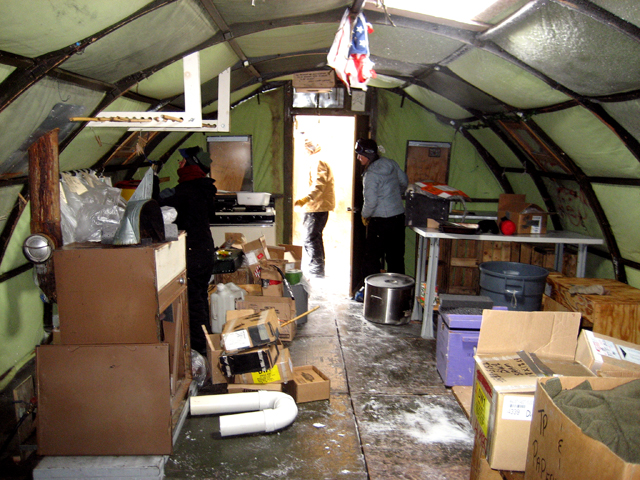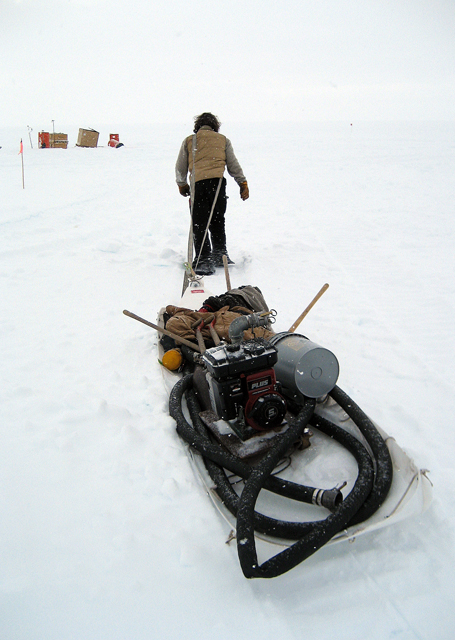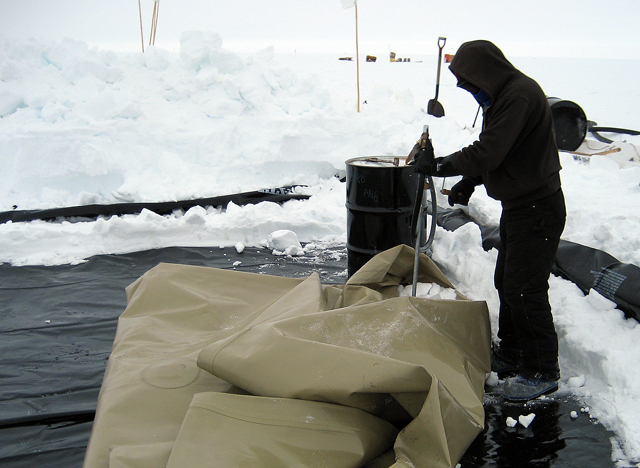Cleaning up ByrdRemains of old field camp removed as NSF prepares to construct new facilitiesPosted June 12, 2009
Kevin Pettway still sounds bone weary about three years after he and a small team of people dug out and dragged away some of the remnants of Byrd Surface Camp during a two-week effort to clean up the site in 2006-07. More on Byrd
“We took out as much as we could in the timeframe allotted to us,” said Pettway,environmental lead at McMurdo Station “It was an abandoned field camp and there were no plans at that time to go back out there,” he explained. About a half-dozen people helped fill about three planeloads of materials, such as Air Force cargo pallets and a Tucker Sno-cat, from the 35-year-old field camp, located about 1,400 kilometers from McMurdo Station. Drifting snow had covered just about everything, including a fuel bladder that had to be shoveled out and then drained of fuel before it could be removed. The work also included manually hauling fuel pumps using banana sleds. “It was super hard work,” said the lanky Pettway who dropped about seven pounds from working long hours outdoors and sleeping in an unheated tent. The team also burrowed its way to the front entrance of a snow-entombed Jamesway, a tent-like building common in field camps, to empty its contents and return reusable materials and waste to McMurdo Station. An international environmental agreement between nations requires that countries now clean up and remove such “releases” to the environment. However, Byrd Surface Camp and the research stations that predated it beginning more than 50 years ago had been left because the environmental effects of attempting to remove them was considered greater than leaving them alone. Those old facilities are buried deep in the ice sheet. “There’s no abandonment now. For WAIS Divide, they have to have a plan to get it out,” said Pettway, referring to a nearby field camp that supports a multi-year ice-coring project in West Antarctica. However, Pettway said an opportunity to remediate the Byrd site came along three years ago, and the NSF decided to clean up the site. The environmental team had planned to return again to dig out the rest of the Jamesway along with a few remaining items including a Caterpillar tractor, but the plans have changed with the revival of the field camp this coming year for a suite of new science programs. “A bunch of stuff got left there,” said Chad Naughton, a science planner for the USAP who helped plan the latest incarnation of Byrd. “Environmental has been wanting to go back there … but they held off because of this project.” The plan is to remove the rest of the old camp as time allows, according to Pettway. One piece will remain for now — that Caterpillar tractor, which still works fine and was used for the remediation project in 2006-07 to prepare an airstrip, or skiway, for incoming planes. “We’re going to use the tractor for Byrd,” Naughton said. |



For USAP Participants |
For The Public |
For Researchers and EducatorsContact UsU.S. National Science FoundationOffice of Polar Programs Geosciences Directorate 2415 Eisenhower Avenue, Suite W7100 Alexandria, VA 22314 Sign up for the NSF Office of Polar Programs newsletter and events. Feedback Form |




